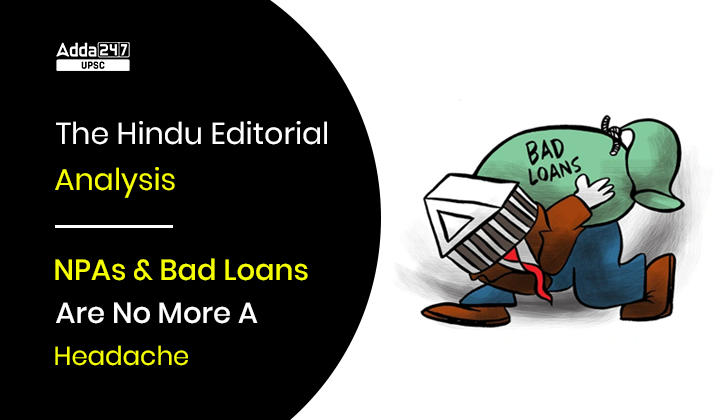Table of Contents
How Can We Say That NPAs & Bad Loans Are No More A Headache: In September 2022, the gross non-performing assets (GNPA) ratio of all Scheduled Commercial Banks (SCBs) was at a seven-year low and the net non-performing assets (NNPA) ratio was at a ten-year low, the latest data from the Reserve Bank of India showed.
These two data points show that the issue of non-performing assets, which was a major headache for banks after the RBI carried out an expansive asset quality review in 2015, is not that troubling anymore.
However, The Minister of State for Finance Bhagwat Karad told the Rajya Sabha in December that loans written off by scheduled commercial banks (SCBs) during the last five financial years totalled ₹10.1 lakh crore. Significantly, only ₹1.32 lakh crore has been recovered. As a percentage of write-offs, this comes to only about 13%.
Videocon-Chanda Kochhar Case Explained
Why In News?
- In December 2022, Finance Minister Nirmala Sitharaman told Parliament that banks had written off bad loans worth ₹10,09,511 crore during the last five financial years.
Background
A National Asset Reconstruction Company Ltd. (NARCL) was announced in the Union Budget for 2021-2022 to resolve stressed loans amounting to about ₹2 lakh crore in phases.
What Is GNPA?
- GNPA ratio is the proportion of gross non-performing assets in gross loans and advances.
- The GNPAs are bad loans which the borrower is not in a position to repay at the moment. A loan turns bad or becomes an NPA if they are overdue for over 90 days.
What Is NNPA?
- NNPA ratio is the proportion of net non-performing assets in net loans and advances.
- Banks have to set aside (or provision) a part of their profit as a buffer for potential losses that may arise from the NPAs. Thus, NPAs reduce a bank’s available capital to lend fresh loans.
- The NNPA deducts these provisions from GNPA and so is a better indicator of the bad loans in a bank’s books.
Factors That Led To The Reduction Of The NPAs
Drop In Slippage Ratio Of SCBs: One important factor that led to the reduction of the NPAs is the drop in slippage ratio of SCBs. The slippage ratio indicates fresh accretion of NPAs in a year. Slippage ratio is arrived at by dividing fresh NPAs by standard advances at the beginning of the period. The slippage ratio is around 2% in September 2022 for SCBs, which is the lowest since at least 2015.
Written Them Off From The Bank’s Books: Banks voluntarily choose to write off NPAs to maintain healthy balance sheets. In the first half of FY23, the loan write-offs as a ratio of GNPAs slightly increased to 22.6% after declining for two consecutive years. So, a combination of both declining slippage and increasing write-offs brought the bad loans to its lowest point in many years.
Drastic Shift In The Sectors: Another factor that led to all the changes mentioned above is the drastic shift in the sectors which the banks funded. In 2016, 40% of all outstanding credit went to industries, whereas just 20% was given out as retail loans. However, by 2022, retail loans’ share surpassed industry credit.
Recovery Mechanisms: The NPA in the industry sector has been brought down since, by a combination of recovery mechanisms such as insolvency and bankruptcy code and also by issuing fewer fresh loans to the industries. On the other hand, bad loans are barely there in the retail sector.
What is a bad loan?
- A bad loan is that which has not been ‘serviced’ for a certain period.
- Servicing a loan is paying back the interest and a small part of the principal — depending on the agreement between bank and borrower — to begin with so that over time, you pay back the principal as well as the interest accrued in the duration.
Govt. To Revamp Insolvency And Bankruptcy Code
Key Benefits Of Reduced NPAs For Banks
- Banks have to “provision” a part of their profit depending on the value and years an NPA exists. Additionally, due to the moratorium during the pandemic, banks had to also set aside some profits as a contingency measure.
- Both factors affected their net profits. However, with reducing NPAs, provisions declined, with moratorium lifted, contingencies were relaxed.
- Due to the above factors, the profitability of the banks improved.
What Is Bank profitability?
- Bank profitability is gauged by measuring a bank’s Return on Assets (RoA = net profit by average total assets). An RoA of >=1% is generally considered good.
- RoA of all scheduled commercial banks had dipped to negative territory in September 2019. By September 2022, it was back to 0.8%, levels last seen in 2014-15.






 TSPSC Group 1 Question Paper 2024, Downl...
TSPSC Group 1 Question Paper 2024, Downl...
 TSPSC Group 1 Answer key 2024 Out, Downl...
TSPSC Group 1 Answer key 2024 Out, Downl...
 UPSC Prelims 2024 Question Paper, Downlo...
UPSC Prelims 2024 Question Paper, Downlo...




